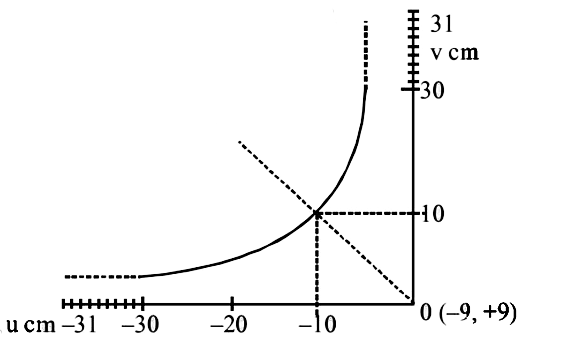The object distance u, the image distance v and the magnification m in a lens follow certain linear relations.
1uversus1v
m versus u
u versus v
m versus v
The correct Answer is:A, D
To solve the problem regarding the linear relations among the object distance u, the image distance v, and the magnification m in a lens, we can follow these steps:
Step 1: Use the Lens Formula
The lens formula is given by:
1f=1v−1u
Rearranging this gives:
1v=1u+1f
This can be considered as a linear equation in the form of y=mx+c, where:
- y=1v
- x=1u
- m=1 (the slope)
- c=1f (the y-intercept)
Step 2: Use the Magnification Formula
The magnification m is defined as:
m=−vu
This can be rearranged to express v in terms of m and u:
v=−mu
This can also be rearranged to fit a linear equation format:
m=−1uv
This can be considered as another linear equation where:
- y=m
- x=v
- m=−1u (the slope)
Step 3: Identify the Relationships
From the above equations, we can identify two linear relationships:
1. The relationship between 1v and 1u.
2. The relationship between m and v.
Step 4: Conclusion
Thus, we can conclude that the object distance u, the image distance v, and the magnification m in a lens follow certain linear relations as described above.
The lens formula is given by:
1f=1v−1u
Rearranging this gives:
1v=1u+1f
This can be considered as a linear equation in the form of y=mx+c, where:
- y=1v
- x=1u
- m=1 (the slope)
- c=1f (the y-intercept)
The magnification m is defined as:
m=−vu
This can be rearranged to express v in terms of m and u:
v=−mu
This can also be rearranged to fit a linear equation format:
m=−1uv
This can be considered as another linear equation where:
- y=m
- x=v
- m=−1u (the slope)
From the above equations, we can identify two linear relationships:
1. The relationship between 1v and 1u.
2. The relationship between m and v.
Thus, we can conclude that the object distance u, the image distance v, and the magnification m in a lens follow certain linear relations as described above.
Topper's Solved these Questions
- RAY OPTICSBOOK - CENGAGE PHYSICS ENGLISHCHAPTER - RAY OPTICSEXERCISE - DPP 1.5
13 Videos
- RAY OPTICSBOOK - CENGAGE PHYSICS ENGLISHCHAPTER - RAY OPTICSEXERCISE - DPP 1.6
12 Videos
- RAY OPTICSBOOK - CENGAGE PHYSICS ENGLISHCHAPTER - RAY OPTICSEXERCISE - DPP 1.3
14 Videos
- PHOTOELECTRIC EFFECTBOOK - CENGAGE PHYSICS ENGLISHCHAPTER - PHOTOELECTRIC EFFECTEXERCISE - Integer Type
4 Videos
- SOURCES OF MAGNETIC FIELDBOOK - CENGAGE PHYSICS ENGLISHCHAPTER - SOURCES OF MAGNETIC FIELDEXERCISE - single correct Ansewer type
12 Videos
Similar Questions
Choose the correct alternative corresponding to the object distance 'u', image distance 'v' and the focal length 'F' of a converging lens from the following .
(i) The average speed of the image as the object moves with the uniform speed from distance 3F4 to F2 is greater than the average speed of the image as the object moves with same speed from distance F2toF4
(ii) The minimum distance between a real object and its real image in case of a converging lens is 4F where F is its focal length.
View SolutionA convex lens is used to obtain a magnified image of an object on a screen . The object is at a distance 10 m from the lens . If the magnification is 19. the focal length of the lens is
View Solution
Knowledge Check
A concave lens forms the image of an object such that the distance between the object and image is 10cm and the magnification produced is 1/4. The focal length of the lens will be
A−6.2cmB−4.4cmC−8.6cmD−10cm
A cocave lens forms the image of an object such that the distance between the object and image is 10 cm and the magnification produced is 1/4. the focal length of the lens will be
View Solution .
.
The graph between object distance u and image distance v from a convex lens is given .The correct option option , from the following ,is
View SolutionThe distance between an object and its upright image is 20cm. if the magnification is 0.5, what is the focal length of the lens that is being used to form the image?
View SolutionA short linear object is placed at a distance u along the axis of a spherical mirror of focal length f.
a. Obtain an expression for the longitudinal magnification.
b. Also, obtain an expression for th eration of the velocity of image (v) to the velocity of the object (u).
View SolutionThe graph shown relationship between object distance and image distance for a equiconvex lens. Then focal length of the lens is

View SolutionThe magnification for a mirror is -3. How are u and v related?
View SolutionA convex lens is placed between an object and a screen which are at a fixed distance apart for one position of the lens. The magnification of the image obtained on the screen is m1. When the lens is moved by a distance d the magnification of the image obtained on the same screen m2, Find the focal length of the lens.
View Solution
